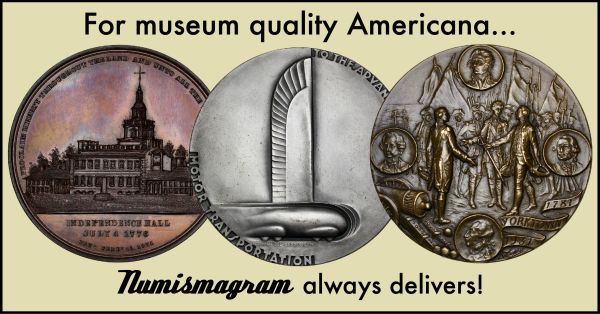
PREV ARTICLE
NEXT ARTICLE
FULL ISSUE
PREV FULL ISSUE
VOCABULARY TERM: GALVANO MEDALHere's another entry from Dick Johnson's Encyclopedia of Coin and Medal Terminology. -Editor Galvano Medal. A medallic item made of one or two galvanos; an electrotype. Galvano medals are all medallic items made by electrodeposition of one or two sides and smaller than eight inches (or 20 centimeters). Larger such items are galvano plaques (almost always one sided). No die is required for these objects as they are not struck. Instead they are formed from a pattern by electrogalvanic casting, and noted for their very high fidelity to that pattern. Thus galvano patterns are highly detailed, galvano medals are likewise. Galvanos are formed in tanks and the limit to their size is bound only by the size of the tank (mostly up to 60 inches). Thus medals, medalets, medallions, plaques, plaquettes (and tablets) can be easily made as galvanos, and all of these – except galvano plaques and tablets – are known as galvano medals. The advantage of galvano medals versus struck medals is their high fidelity, plus the fact they are ideal for short runs. If say less than 50 items are required – ever! – it is cheaper and quicker to make them by galvano casting than by creating a die or dies and striking. If more than 50 are required it is better to have dies made that can be struck at any time. Dies or galvano patterns are made from artist's models and can be stored for future use. History. Galvano is named after an Italian, Luigi (or Alolsio) Galvani, who, in 1791, first observed electric current. Michael Faraday, an Englishman, developed the generation of direct current in the 1830s. But it was a German, Moritz Herman von Jacobi (1801-1874), who developed, in 1837, the process using electric current he called "galvanoplasty" which today is known as electroforming. The British immediately embraced this process to create electroplating, obtaining the first patents in 1840. The British also used this process to replicate, or duplicate, existing small bas-relief objects. The British Museum, in 1859, appointed a sealmaker, Robert Cooper Ready (1811-1901), to electroform objects – including coins and medals – in the Museum's collections. (In his lifetime Ready made over 22,000 of these, and his son, Augustus P. Ready carried on after him.) See electrotype. Galvano medal characteristics. Each side of a galvano medal is made separately. A one-sided galvano casting is usually backed with metal to give it additional strength, as it can be made extremely thin. A two-sided galvano medal is made by attaching a flat back or a second galvano to form the reverse with design. Two-sided galvanos are joined together with a drop-in, a molten medal – as lead, solder or pot metal – is applied to fill the inside cavity and to make it a somewhat "solid" medal. With two sides joined together, there is, of course, a seam around the edge. Fortunately galvanos can be made in typical coin and medal compositions – copper, silver, gold – and can be made to resemble a numismatic item in these compositions (called electrotypes by numismatists). Any pure metal that conducts electricity can be electroformed (including nickel, chromium, palladium, others, or, these can also be employed to electroplate any hard surface). Galvanos can be finished or left uncolored. They can be highlighted or given a patina finish. Copper galvanos can be easily finished to replicate any bronze color. Untreated copper galvanos will turn brown from their original copper red just like an untreated coin. They can be lacquered to retain their original patina color or left unlacquered to tone or darken naturally. Galvano medal diagnostics. Thus the diagnostic evidence to identify galvano medals are: (1) a seam around the edge if two-sided, (2) a composition of pure metal element (usually copper), (3) possible additional metal added to the back or inside for strength, (4) a lighter weight and different specific gravity than a solid medal of similar diameter. All other evidence would indicate a struck piece as well as an electroformed medal. Cataloging galvano medals. In numismatic cataloging, galvano medals should be identified as what they are. Their composition is not obvious from inspection but the color should be mentioned (copper red or brown, silver gray, gold yellow); it is not necessary to identify the composition of the drop-in but this should be mentioned if it is present (and not covered by a backplate). Galvanos can be given a patina finish and this, too, should be mentioned in cataloging. For additional information, particularly on the fidelity of a galvano casting to its pattern, see electrotype, electroforming and electroplating.
References:
To read the complete entry on the Newman Numismatic Portal, see:
Wayne Homren, Editor The Numismatic Bibliomania Society is a non-profit organization promoting numismatic literature. See our web site at coinbooks.org. To submit items for publication in The E-Sylum, write to the Editor at this address: whomren@gmail.com To subscribe go to: https://my.binhost.com/lists/listinfo/esylum All Rights Reserved. NBS Home Page Contact the NBS webmaster 
|
